BQ-Bank: A Quantum Software for Finance and Banking
Abstract
The power of quantum computing may bring a revolution in finance and banking. Here, we present quantum software, BQ-Bank for option pricing, Value at Risk, portfolio optimization, and others. BQ-Bank can be run on a real quantum computer such as superconducting system or on an emulation system based on a classical computer with an interface. BQ-Bank, such as other quantum types of software, represents a new generation of the toolbox that likely brings disruptive innovations to the financial industry and banking market in the future. BQ-Bank also provides the classical Monte Carlo solution, so that users can compare their quantum results with classical ones directly. Our simulation results for a variety of examples show the superiority of quantum solutions.
1. Introduction
Based on quantum physical principles, such as quantum superposition and quantum entanglement, quantum computers [1, 2] can provide unprecedented powerful computational capabilities. Compared with classical algorithms, quantum algorithms possess tremendous speedup in solving certain problems, such as Shor’s algorithm [3] for integer factorization, Grover’s algorithm [4, 5] for unsorted database search, and Harrow–Hassidim–Lloyd (HHL) quantum algorithm [6] for linear systems of equations.
Quantum computers are expected to have a substantial impact on the financial industry and banking market [7, 8]. Financial institutions such as J. P. Morgan Chase, Barclays Bank, and Goldman Sachs Group have already established collaborations with quantum computing companies such as IBM and Amazon to explore the use of quantum computing in finance. Spanish bank CaixaBank has also joined hands with IBM to develop a financial asset risk analysis simulation project. Canada’s BMO Financial Group and Scotiabank have partnered with Australian quantum computing startup Xanadu to develop quantum Monte Carlo algorithms to improve the efficiency of financial transactions and optimize real-time pricing. Recently, Everbright Technology, together with the Beijing Academy of Quantum Information Sciences and Boson Quantum Technology, has released a quantum portfolio product–Tiangong Jingshi (https://finworld.qboson.com) quantum computing quantitative strategy platform.
On the one hand, the concept of quantum computing can be mysterious to the general public, and performing quantum algorithms requires prior knowledge for people in the finance and banking sectors and is beyond their capabilities on their own; this limits the desire of the public to explore in the quantum computing world; on the other hand, experts in quantum computing are interested in how quantum computing can apply in the industry such as finance and banking but do not know how to realize them.
Here, we report a quantum software platform designed for the finance and banking industry, Biwon Quantum Bank (BQ-Bank) (http://biwonq.baqis.ac.cn/#/pages/finance). It includes four commonly used modules in finance and banking: option pricing, option revenues, Value at Risk (VaR), and portfolio optimization. With the graphical interface and preset data, one can access and use the previous four modules without any prior knowledge of quantum computing, helping the public especially financial workers to learn and perform applications of quantum computing in finance.
2. BQ-Bank
In this section, we present quantum algorithms that are required in finance and banking, and demonstrate how they are harnessed to solve problems in the modules. In each module, we first offer detailed descriptions of the problem and models, then introduce the solution with conventional classical methods of simulation, and a quantum solution. Finally, we compare the results of the conventional method with its quantum counterpart. More specially, in subsections 2.1 and 2.2, we introduce how quantum amplitude estimation algorithm can apply to calculating option pricing and VaR; and in subsection 2.3, we give a simple description of quantum approximate optimization algorithm (QAOA), a method that is believed to be adaptive to current noisy devices.
2.1. Option Pricing and Revenues
2.1.1. Black-Scholes Option Pricing Model
An option is a right for the buyer in a contract, who can choose whether to exercise the right or not. Therefore, the option buyer needs to pay a certain price to the option seller for the option right. The price of option buying and selling is often determined by the option market exchange, which reflects the entire option market’s assessment of the future price trend of the underlying asset. However, such a method is often not that efficient, and options market prices often fail to reflect their actual prices, especially in markets with smaller volumes. So, we need a price to guide options trading. On the other hand, a large number of speculators in the market need to evaluate the difference between the market price of the option and its actual value, to invest in option buying and selling.
The research on option pricing can be traced back to the year 1900, when French financial expert Laures Bachelier discussed option pricing in his doctoral dissertation [9]. Since then, various option pricing models have been proposed, such as the binomial option pricing model [10, 11], trinomial option pricing Model [12], and Black-Scholes option pricing model [13]. Among these, the Black-Scholes model is the most widely known, which was proposed by Fisher Black and Myron Scholes and furthermore developed by Robert Merton.
Generally, to use the Black-Scholes model to estimate the price of an option, say, European-style call and put option, some assumptions shall be made, such as the revenues of the underlying asset follows a normal distribution, the risk-free rate is constant, and investors can borrow unlimitedly at this rate, (more details can be found in “Section I: Option Pricing and Black-Scholes Model” of the supplementary material from section VIII of the main manuscript.)
A classical simulation method for calculating the option pricing value is Monte Carlo simulation, which is widely used for dealing with uncertainty in many aspects of business operations. In option pricing, Monte Carlo simulation can be used for sampling estimation to calculate the value of an option with multiple sources of uncertainties and random features.
2.1.2. Quantum Solution
- (1)
Generate M expiration date prices {X1, X2, ⋯XM} for the underlying asset by a stochastic process
- (2)
Calculate M revenues of the option f(Xi) at each price Xi
- (3)
Obtain the averaged revenues on the expiration date in a risk-neutral world:
() - (4)
Calculate its present value which is the option price, where r is the risk-free interest rate and T is the option expiration date.
The quantum option pricing algorithm starts with generating the quantum state of the option revenues and the underlying asset distribution on the expiration date. Then, the quantum amplitude estimation algorithm [14–17] (QAE, for more details, see “Section II: Quantum Amplitude Estimation” in the supplementary material from section VIII of the main manuscript.) is utilized to obtain the option price.
-
Step 1. Under the assumption of random walk theory, the price distribution of the underlying asset at the option expiration date T is
() -
After sampling and discretizing of the distribution into pi, they are encoded into the amplitudes of a certain n− qubit basis, and the corresponding state can be efficiently prepared by parameterized quantum circuits [18]:
() -
where i corresponds to the price ST in (7).
-
Step 2. For the revenue function of f(ST) = max (0, ST − K) in the case of call option, the revenue function can be divided into two parts, ST < K and ST ≥ K. This is achieved by adding an extraqubit (the (n + 1)-th qubit) to the system, distinguishing the two parts with |0〉 and |1〉 of the (n + 1)-th qubit, respectively.
() -
Step 3. By encoding the revenue function f(i) into a special function which satisfies
() -
and adding an ancillary qubit initialized in state |0〉a, the first (n + 1) qubits can be used as control qubits to rotate the ancillary qubit as an angle in a function of as follows:
() -
Step 4. After the measurement, we obtain the probability for which the (n + 1)-th qubit and the ancillary qubit both in state |1〉:
()
Now, it is clear that can be calculated with the probability P, and it follows that the result value of current option is also on a silver platter.
2.1.3. Examples and Results
In the previous subsection, one see that quantum computing plays an important role in option pricing. However, for the general public, due to the mysteriousness of quantum computing itself, and it is neither easy nor practical to learn quantum computing and quantum programming. To overcome this problem, we have established a BQ-Bank web page, which provides software applications related to option pricing with a friendly user interface. We illustrate our modules for option pricing and option revenues with concrete examples.
- (1)
The current market price of the underlying asset
- (2)
The option contract’s valid period
- (3)
The risk-free interest rate
- (4)
The annualized volatility
- (5)
The option exercise price
- (6)
The choosing option of call or put options
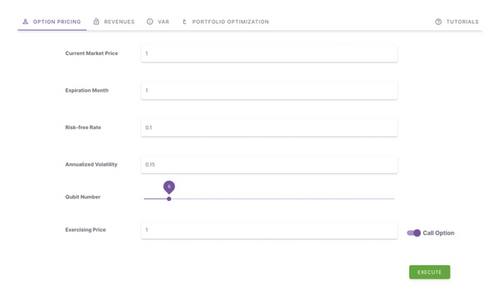
- (1)
Black–Scholes model
- (2)
Quantum algorithm
- (3)
Classic Monte Carlo algorithm
In conducting option pricing with the quantum algorithm, the users need to input the number of qubits (denoted with n) in the user interface. For the convenience of comparison, the sampling number of the classic Monte Carlo algorithm is set to 2n. After clicking the execution button, the calculation result is shown in Figure 2, with respect to the standard value shown by the Black–Scholes model, and the result of option pricing from the quantum algorithm is better than that from the classical Monte Carlo algorithm. Because of the randomness involved in both algorithms, the results will vary slightly from run to run.
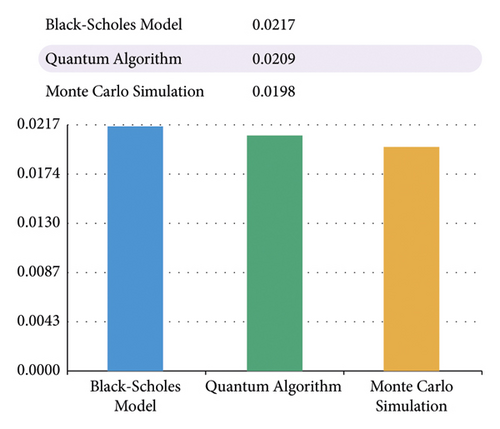
(2) Option Revenues. Due to the discrepancy between the option price calculated by the theoretical model and the option price in the real market, speculators can arbitrage by buying and selling options. An application for calculating the expected option revenues strategy is also integrated into BQ-Bank, and the quantum algorithm in the backend is still based on the previous quantum option pricing algorithm. Specifically, this module calculates the expected option revenues portfolio by estimating the price of each option with a quantum option pricing algorithm and comparing it with the option market price.
Similar to the inputs of option pricing, one can find the user interface for calculating expected option revenues in Figure 3. In addition to four inputs (i.e., the current market price of the underlying asset, the option contract’s valid period, the risk-free interest rate, and the annualized volatility of the asset), there are also other user input parameters required to construct an option portfolio. For example, to add another pattern of options by clicking the “+” sign icon at the end of its option input line, and to delete one pattern of options by clicking its respective “trash can” icon. Each pattern of options contains the option for call/put option, the option for buying/selling options, its exercising price and the option fee.
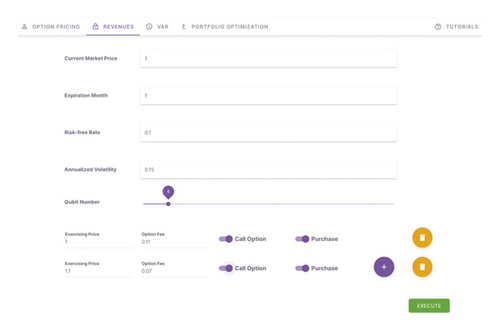
After executing the calculation, the result is shown in Figure 4. From the figure, we can get the estimated value of the expected revenues obtained by the three algorithms for the option portfolio we set. With respect to the standard value shown by the Black-Scholes model, the result with the quantum algorithm is better than the classical Monte Carlo algorithm’s. Also, due to the randomness involved in both algorithms, the results will vary slightly from run to run.
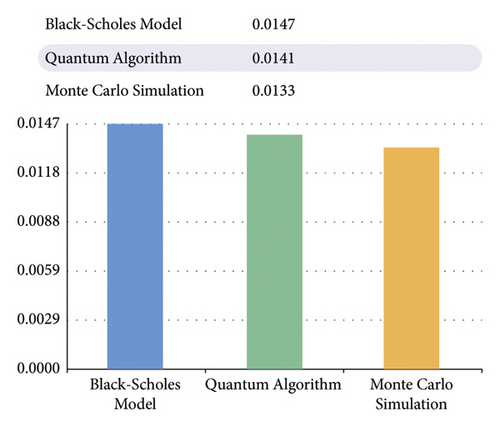
2.2. Value at Risk (VaR)
2.2.1. Classical Solution
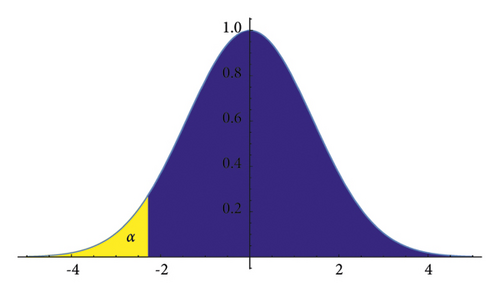
There are three kinds of classical VaR algorithms, namely, Historical VaR (H-VaR), Parametric VaR (P-VaR), Monte Carlo VaR (MC-VaR) [20]. However, these algorithms rely on different assumptions, so that their final VaR values are often different.
(1) H-VaR. When we have a certain amount of historical data in our hands but do not know the probability distribution of asset losses, we can assume that the asset’s future losses and gains are merely repetitions of past situations. Then, we use the VaR of the historical data to estimate the future VaR. The specific method is to sort the historical data by size, and determine the position of VaR in the sorting according to the product of the probability α and the size of the historical data.
(2) P-VaR. If we assume that the asset’s loss distribution follows a normal distribution, we can use historical data to estimate the mean and variance of the normal distribution, then use the normal distribution function to calculate the VaR at the probability α.
2.2.2. Quantum Solution
Employing the QAE algorithm, we can obtain the quantum state probability with the ancillary qubit in state |1〉.
Thus, we can get the probability of the ancillary qubit in state |1〉, . When x ≤ k, there exists FX(x ≤ kα) ≥ α, which means kα is the VaR with a confidence of α and a precision of O(M−1), showing the quantum algorithm has a quadratic speedup compared to the classical MC-VaR method O(M−1/2).
2.2.3. Examples and Results
Now, we show how three different classical VaR algorithms, H-VaR, P-VaR, and MC-VaR, and our quantum algorithm perform for the same instance. As we can see, in the case studied in Figure 6, we choose the normal distribution as our model, 0.95 confidence and 30 holding days of assets which are combined of two assets, China Bao An and Ping An Bank with 10 of each are purchased.
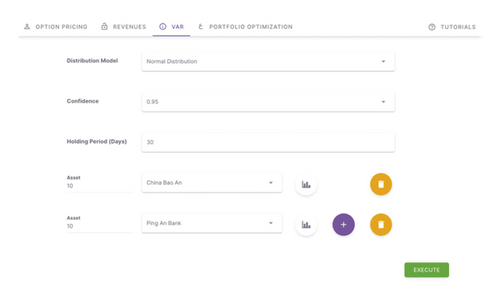
The results for both classical and quantum methods in different sampling points are shown in Figure 7, where we see that H-VaR and P-VaR are independent of the sampling points, which is quite intuitively obvious since both are calculated mainly based on historical data of assets without any sampling. As to MC-VaR, its VaR approaches to P-VaR with sampling points increasing, and even at 512 sampling points, there are still a small difference between P-VaR and MC-VaR. While the VaR with quantum algorithm approaches P-VaR monotonically with sampling points increasing and at 32 or larger sampling points, the VaR with the quantum algorithm is exactly equal to P-VaR. As the result shown in this instance, the VaR with the quantum algorithm is closer to P-VaR than that with the Monte Carlo method at the same sampling point, and we argue that the quantum algorithm performs better than the Monte Carlo method.
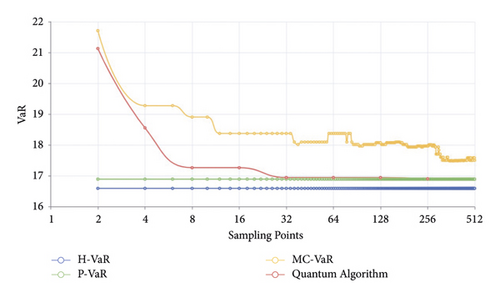
2.3. Portfolio Optimization
2.3.1. Model
Portfolio optimization [23] is an important problem that many investors will encounter. It requires investors to invest in candidate financial assets in order to minimize the risk under the condition of a certain return or maximize the investment return under the condition of a certain risk. If the number of candidate assets is very large, the classical algorithms used to solve such problems usually have high time complexity and are difficult to implement. Thanks to the powerful computing performance of quantum computing, the quantum algorithm can give the portfolio of assets with the optimal budget number among the candidate assets [24].
- (i)
x ∈ {0,1}n in quantum algorithms represents the vector of binary decision variables. If the asset i is purchased, xi = 1 and xi = 0 when not. xi ∈ [0,1] in classical algorithms is the weight of purchasing the corresponding asset, and ∑ixi = 1.
- (ii)
represents the expected return of each asset.
- (iii)
represents the covariance between the expected returns of each asset.
- (iv)
q > 0 is the risk factor, which indicates the investor’s investment risk preference.
- (v)
1 represents a n-dimensional vector whose elements are all 1 s.
- (vi)
b represents the investment budget, which is the number of assets purchased from n assets in quantum algorithms case (assuming the price of each asset is 1). Usually, b = 1 in classical algorithms case.
2.3.2. Quantum Solution
Our portfolio optimization scheme uses a combination strategy of classical and quantum methods. First, it uses quantum algorithms to select the optimal portfolio of assets with a budgeted number of n candidate assets. Then, it uses classical algorithms to calculate the assets selected by quantum algorithms (i.e., QAOA). Finally, it predicts the optimal strategy of purchasing assets and achieves maximum returns. With the aid of quantum algorithm, we can filter out the assets that do not need to be purchased, and the difficulty in implementing the classical algorithm is greatly reduced.
QAOA [25, 26], which can be classified as a variational quantum algorithm (VQA) [27, 28], is a quantum algorithm with a wide range of applications in the recent Noisy Intermediate-Scale Quantum (NISQ) [29] era. QAOA was proposed by Edward Farhi et al. in 2014 to approximately solve the combinatorial optimization problems. For a combinatorial optimization problem, which can be defined by a binary string of n bits z = z1 … zn, the aim is to determine the string that minimizes or maximizes the classical objective function .
Usually, the greater of the probability that the ground state is measured in the eigenstate of Hc, the greater of the probability that its corresponding bit string ei is the optimal solution.
2.3.3. Examples and Results
- (1)
All assets should have the same price (assumed to be 1)
- (2)
The given budget should be an integral multiple of the price of an asset, and it needs to be all used for investment, which means that b assets need to be purchased
In this case, the portfolio optimization problem under these two assumptions corresponds to choosing a subset of b assets from n assets. We need to convert the loss function shown in (23) into a Hamiltonian to complete the encoding of the portfolio optimization problem. Because the value of the binary variable xi (0 or 1) indicates whether the asset needs to be purchased, we need to construct a Hamiltonian whose eigenvalues corresponding to them. Since the eigenvalue of the Pauli operator σz is ±1, we can construct the Hamiltonian as , which corresponds to two eigenvalues 0 and 1. So, one can use the mapping to convert the loss function Lx into a Hamiltonian whose ground state corresponds to the optimal solution of the portfolio optimization problem.
As mentioned previously, we use a variational quantum algorithm, especially QAOA, to approximately solve the ground state of a Hamiltonian. Here, we list the procedure how we solve the portfolio optimization problem with QAOA and other algorithms:
(1) Preparation. For each candidate asset x, given its preferred maximum share maxx and minimum share minx (where maxx , minx ∈ [0,1]) of the combinatorial assets, purchased assets budget b(b ⩽ n), risk factor q, and historical period of all candidate assets [ti, tf], as shown in Figure 8.
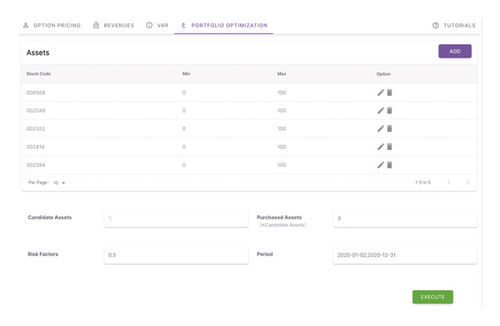
(2) Assignment. When the minimum share of an asset satisfies minx > 0, it means the asset will definitely be purchased and will be assigned into the assets set X1, and the total number of the assets set X1 is defined as n1. Else when minx = 0, the asset needs to be determined by QAOA whether it needs to be purchased or not, and which asset will assigned into another assets set X2.
(3) Optimal Selection with QAOA. Since there are already n1 assets that have been determined to be purchased for sure, only (b − n1) assets need to be selected from the set X2 using QAOA. According to the mapping , the loss function Lx can be converted into a systematic Hamiltonian HC with qubit number (n − n1), and the ground state of this Hamiltonian is the optimal solution, where the mixing Hamiltonian is .
- (i)
Quantum Part. Prepare a variational state |φ(θ, β)〉 = U(θ, β)| + 〉⊗n on a quantum computer, where , and then obtain the expectation of Hamiltonian |φ(θ, β)〉 = U(θ, β)+〉⊗n.
- (ii)
Classical Part: Update θ, β with the classical optimization algorithm, such as COBYLA, and go back to the quantum part until λ approximately reaches a minimum. The optimal combination of assets to be purchased, as defined , is obtained from the variational state at this point, and the optimal combination of assets to be purchased is .
(4) Proportion Optimization. Finally, a trust-constr constraint algorithm is used to give the optimal proportion of the assets in the optimal portfolio to the constraints of every asset as assigned in the preparation step. Figure 9 shows the optimal result of an input example corresponding to Figure 8, including the optimal portfolio and its corresponding history return curve.
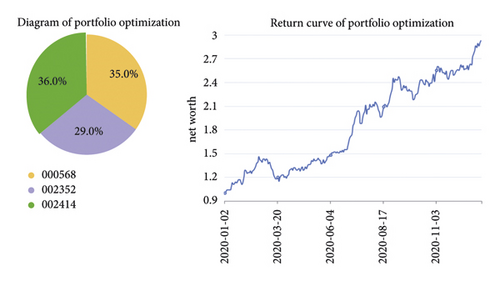
3. Summary
We have developed a quantum software BQ-Bank, which comprises 4 modules: option pricing, option revenues, VaR, and portfolio optimization. In each module, we start with the underlying problems and models, then we discuss the conventional algorithms and their quantum solution, and at the end we take an example and compare the results of the conventional algorithms with their quantum solution. The results show that the quantum solution usually outperforms the conventional algorithms. With the succinct design and the preset data set of BQ-Bank, people with or without quantum background can access and complete their interest tasks on a silver platter without trained skills.
Conflicts of Interest
The authors declare that they have no conflicts of interest.
Acknowledgments
The authors would like to thank Dr. Zai-sheng Lin for helpful discussions. This work was supported by the National Natural Science Foundation of China (Grant nos. 12004206 and 12005015).
Open Research
Data Availability
The data sets generated and/or analyzed during the current study are available from the corresponding author upon reasonable request.




